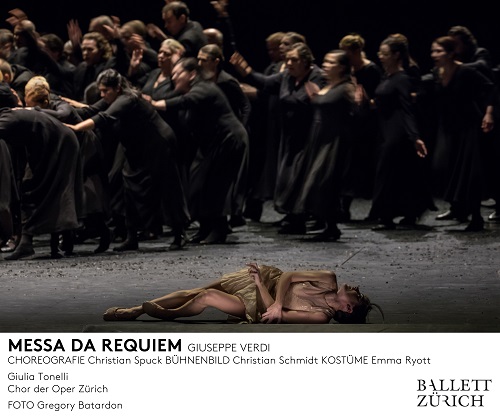 Switzerland Verdi: Soloists, Krassimira Stoyanova (soprano), Veronica Simeoni (mezzosoprano), Francesco Meli (tenor), Georg Zeppenfeld (bass), Zurich Ballet, (augmented) Chorus of the Zurich Opera, Philharmonia Zurich / Fabio Luisi (conductor), Zurich Opera, Zurich, 3.12.16. (JR)
Switzerland Verdi: Soloists, Krassimira Stoyanova (soprano), Veronica Simeoni (mezzosoprano), Francesco Meli (tenor), Georg Zeppenfeld (bass), Zurich Ballet, (augmented) Chorus of the Zurich Opera, Philharmonia Zurich / Fabio Luisi (conductor), Zurich Opera, Zurich, 3.12.16. (JR)

Verdi: Requiem
Production:
Choreography – Christian Spuck
Set – Christian Schmidt
Assistant stage design – Florian Schaaf
Costumes – Emma Ryott
Lighting – Martin Gebhardt
Chorusmaster – Marcovalerio Marletta
Dramaturgy – Michael Küster, Claus Spahn
It needed a degree of courage on everyone’s part to put on Verdi’s Requiem on the opera-house stage, with ballet. Certainly many say the work is more operatic than simply a choral work, more secular in style than liturgical; Verdi was an avowed agnostic surrounded by fervent Catholics. The soloists and chorus needed courage and motivation to participate in the “action” on stage, and to some extent hardened opera-lovers and lovers of choral music needed courage not to be distracted by the “goings-on” on stage. Ballet lovers needed no encouragement, they were clearly delighted with what they experienced. There are however, I suspect in all opera houses, two fairly distinct audiences – lovers of opera and lovers of the ballet. I know several opera lovers, who would not be seen dead at the ballet, and vice versa; many however are willing to crossover from time to time and this performance was just such a time.
Management needed courage to be innovative, to meet the artistic and financial challenge, for ten performances over the festive period. It’s hardly a jolly Yuletide piece.
So, does it work? It’s certainly not Verdi’s Requiem as you know it. Peter Sellars (aided by Simon Rattle) brought the St Matthew Passion to life but it wasn’t everyone’s cup of tea and I suspect this dance-version of the Verdi Requiem will not be to everyone’s liking. The audience at the première were principally the habitual ballet audience and, though there some boos from the gallery at the end, most were ecstatic. Traditional lovers of choral music may well have found the ballet element an irritating distraction. It all just goes to show that you cannot please all the people, all of the time.
Regular ballet-lovers said this was some of the finest choreography by Christian Spuck, Director of Zurich Ballet. It’s a piece of music he has admired from an early age and one he has long wanted to put on the stage.
The set is a large, dark, grey, gloomy room, taking up the whole stage with slate walls (a “wailing wall” on which, at one point, the chorus and soloists write some appropriate words in chalk) and a roof with large square holes in it to allow for lighting. The walls have no doors, the chorus is trapped as though in a giant gas chamber. When the roof descends slowly at the very end to seemingly crush the singers and dancers, I thought of Aida and Radames in their tomb. On top of the stage lay a motionless figure, supposed dead, a reminder – if we needed it – that we are all mortal.
Spuck’s idea for his ballet was not to attempt to tell any sort of story to fit the words but keep it as abstract as possible, though clearly grief and death are central and recurring and recognisable elements.
Fabio Luisi lined up four spectacular soloists. Krassimira Stoyanova is a Bulgarian soprano, Kammersängerin at the Vienna opera. She has sung the Requiem for Jansons: nothing short of first-rate. Veronica Simeoni is an Italian mezzo who sang the work, on CD, for Temirkanov. Her movement around the stage and facial expressions were, of the four soloists, the most convincing. The men acted less. Francesco Meli, from Genoa, is a regular at Salzburg, La Scala and Covent Garden. His head voice in “Hostias” was not his strongest suit, but lower down he had heft in reserve and occasionally over-used it. Georg Zeppenfeld is a Kammersänger at the Semper Oper, Dresden, and best known nowadays, apart from the role of Sarastro at the world’s most prestigious opera houses, for his Gurnemanz at Bayreuth. He will sing Hunding at Salzburg next Easter. When he sang alone, as in “Mors stupebit”, you didn’t watch the ballet.
I must admit I found the ballet occasionally off-putting, a lessening of the impact of this magnificent choral work. It took some getting used to; at the beginning I kept shutting my eyes finding the dancers’ gyrations irrelevant. Later, I too picked up some courage and watched. In “Dies irae” the chorus ran about wildly, sometimes with their hands stretched out, sometimes with their hands seemingly tied behind their backs, whilst one or two virtually naked mud-covered male dancers writhed. Trumpets positioned round the amphitheatre sounded their fanfares most impressively, though one fluffed his notes.
The orchestra, in the pit, never really caught one’s attention but, in Luisi’s expert hands, were well up to their task. Marcovalerio Marletta, former chorus-master at Santa Cecilia in Rome, coached the chorus and the experience showed – they have rarely sung better. Sadly, “Sanctus” had a shaky start from an ensemble and timing point of view.
Costumes by Englishwoman Emma Ryott were almost all, fittingly, in black, the prize going to the huge ballgown for the soprano’s final and very striking intonation of “Libera me”, the skirt looking like sheathes of ashen paper.
So, whatever will they think of next? An orchestrated version of Winterreise perhaps? Yes, actually someone has, watch this space.
If you cannot get to Zurich to experience their version of Verdi’s Requiem (and the charming Christmas market right outside the opera-house), Arte filmed the performance and will show it on their cable TV channel on Sunday, December 18th at 11.05 p.m. (Central European time), hardly peak viewing time. Come on Arte, courage!
John Rhodes
